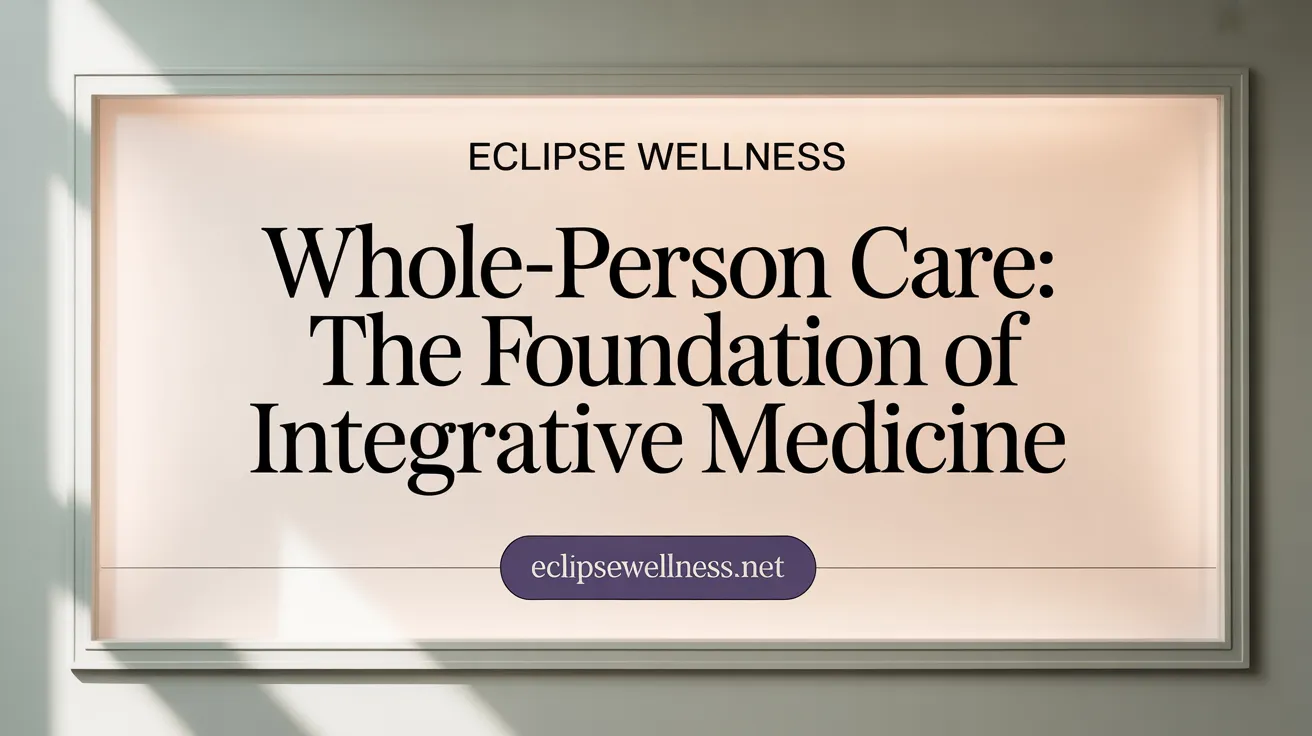Understanding the Integrative Health Paradigm
Integrative medicine blends the strengths of conventional medical treatments with holistic, evidence-based therapies to create a comprehensive, patient-centered approach. As healthcare evolves, this multidisciplinary strategy addresses not just symptoms but the whole person—mind, body, and spirit—fostering deeper healing and wellness. This article explores how combining holistic practices with modern medicine benefits patients managing chronic conditions, preventing disease, and improving overall quality of life.
The Foundation of Integrative Medicine: Whole-Person Care

What defines integrative medicine and its approach to healthcare?
Integrative medicine is an approach that blends conventional medical treatments with complementary and alternative therapies supported by scientific evidence. This discipline centers on treating the whole person—mind, body, and spirit—rather than focusing solely on isolated symptoms or diseases.
The foundation of integrative medicine lies in its whole-person approach. It takes into account a broad spectrum of health influences, including physical health, emotional well-being, mental clarity, spiritual health, behavior, psychosocial elements, and environmental factors. By acknowledging these interconnected dimensions, integrative medicine offers a comprehensive pathway toward health and healing.
A distinctive aspect of this approach is the partnership between patient and provider. Care is personalized and collaborative, with both parties working together to develop tailored treatment plans. This relationship fosters empowerment, as patients actively participate in decisions regarding their care, ensuring therapy aligns with their unique needs and values.
In summary, integrative medicine's whole-person focus combines advanced medical therapies with holistic care practices. This synergy promotes not only disease treatment but also prevention, health promotion, and overall well-being. The collaborative doctor-patient relationship is essential, emphasizing trust, communication, and personalized attention to foster optimal health outcomes.
Advantages of Integrating Holistic Therapies with Conventional Treatments

What are the key benefits of combining holistic therapies with conventional medicine?
Integrative medicine blends natural, less invasive holistic therapies such as acupuncture, yoga, meditation, and herbal treatments with conventional medical approaches. This combination offers several notable benefits.
Firstly, it emphasizes the body's innate healing abilities, supporting natural recovery processes without heavy reliance on pharmaceuticals. Patients often experience enhanced relaxation and stress reduction through mind-body practices, which complement conventional care.
Secondly, this approach prioritizes disease prevention and health promotion by addressing lifestyle factors like nutrition, exercise, sleep, and stress management. This holistic focus can help prevent or better manage chronic diseases such as diabetes and heart disease.
Importantly, integrative medicine reduces medication dependence by providing alternative therapies that can alleviate symptoms and improve quality of life. Consequently, patients may have fewer side effects and lower risks related to long-term drug use (source).
Finally, managing chronic conditions becomes more comprehensive, as the whole person—including biological, behavioral, and psychosocial aspects—is considered. This personalized care often leads to fewer hospital visits and better long-term health outcomes.
In summary, integrating holistic therapies with conventional treatments fosters a natural, preventive, and patient-centered approach that enhances chronic disease management and overall well-being (source).
Evidence-Based Complementary Therapies and Their Integration

Which complementary therapies are supported by evidence and how are they integrated?
Complementary and alternative medicine (CAM) includes a variety of practices, many of which have gained scientific validation for safety and efficacy. Notable evidence-based therapies include acupuncture, meditation, massage therapy, yoga, and select herbal medicines. These therapies are often used alongside conventional treatments to enhance patient care rather than replace it. Learn more about evidence-based CAM therapies.
Examples of CAM therapies
CAM encompasses several domains such as mind-body interventions (meditation, yoga, biofeedback), biologically based treatments (herbal supplements, dietary changes), manipulative methods (massage, chiropractic), and energy therapies (Reiki, Qi Gong). Acupuncture, originating from Traditional Chinese Medicine, is widely recognized for pain relief and anxiety reduction. Meditation and yoga support stress management and overall mental well-being. Explore types of complementary and alternative medicine.
Scientific validation and safety
Clinical research, including randomized controlled trials, underpins the growing acceptance of these therapies. Studies have demonstrated benefits in managing chronic conditions like cancer-related fatigue, fibromyalgia, migraines, and hypertension. While many CAM treatments are safe, caution is advised, especially with herbal supplements due to potential drug interactions. Healthcare providers encourage open dialogue regarding CAM use to ensure coordinated and safe care. See in-depth scientific evaluation of CAM.
Incorporating CAM into medical education
Medical curricula increasingly integrate training on CAM therapies to equip healthcare professionals with knowledge about these options. This enhances understanding of patient preferences and allows practitioners to guide safe and effective use of complementary therapies in clinical practice. Read about CAM integration in medical education.
Common uses of CAM in clinical settings
Patients often seek CAM to manage chronic pain, reduce treatment side effects, enhance quality of life, and promote holistic health. Integrative medicine clinics within hospitals provide multidisciplinary care teams that include acupuncturists, nutritionists, and massage therapists working in concert with physicians to optimize individualized treatment plans. Learn about integrative medicine clinics and collaborative care.
Holistic Medicine’s Role in Addressing Root Causes and Patient Empowerment

How does holistic medicine focus on root causes and empower patients?
Holistic medicine goes beyond merely treating symptoms by focusing on the underlying causes of illness. It looks at crucial factors such as gut health, mental health, stress sources, and physical strength to provide comprehensive care. This whole-person approach means that biological, behavioral, psychosocial, and environmental aspects are all considered when designing treatment plans.
Patient participation is a central component of holistic care. Practitioners work collaboratively with individuals, encouraging active involvement in health decisions and supporting lifestyle changes like improved nutrition, stress management, and exercise. This empowers patients to take responsibility for their well-being and promotes self-healing.
Importantly, holistic medicine tailors care to each individual’s unique needs, including cultural background, beliefs, and personal preferences. By delivering culturally competent and personalized care, it fosters trust and respects diversity, which enhances treatment effectiveness and patient satisfaction.
Integrative Care Models Improving Patient Outcomes and Healthcare Systems
What impact does integrative medicine have on patient outcomes and healthcare efficiency?
Integrative medicine significantly enhances patient outcomes and overall healthcare efficiency. Research and clinical reports reveal that integrative medicine programs improve symptom management — including reductions in pain, fatigue, and emotional distress — especially in patients with chronic diseases and cancer. This approach promotes better quality of life by addressing physical, emotional, and spiritual health collectively (Integrative Medicine and Health at Mayo Clinic, Benefits of integrative medicine.
Effectiveness in chronic disease and cancer care
Patients with chronic conditions like autoimmune diseases, chronic pain syndromes, and cancer benefit from integrative treatments such as acupuncture, nutritional counseling, mind-body therapies, and massage. These therapies support the body’s natural healing, reduce side effects of conventional treatments, and manage symptoms effectively (Integrative Medicine Overview, Integrative Medicine and Health at Mayo Clinic). For example, integrative oncology services have demonstrated improvements in cancer-related fatigue and psychological well-being (Integration of CAM and conventional medicine, Complementary and Alternative Medicine for cancer).
Patient satisfaction and quality of life
Integrative care fosters strong patient–provider relationships by emphasizing shared decision-making and personalized care tailored to individual needs. Patients report increased satisfaction due to feeling heard and having more control over their treatment plans. The holistic focus on mind, body, and spirit results in better emotional functioning and a greater sense of empowerment (Integrative Medicine Therapies, Holistic health approach).
Reducing hospital costs and visits
Studies indicate that integrative medicine can lead to fewer hospital readmissions and emergency visits. By emphasizing prevention, lifestyle modification, and symptom control, integrative care reduces the need for extensive medication and hospital-based interventions, ultimately lowering healthcare costs (Integrative medicine impact studies, Benefits of integrated health care plans).
Collaborative interdisciplinary care teams
Integrative medicine is delivered by interdisciplinary teams including physicians, acupuncturists, nutritionists, massage therapists, and psychologists who coordinate care. This collaboration ensures safety, efficacy, and comprehensive management of patient health, achieving better clinical outcomes while supporting the patient's whole-person needs (Integrated health care collaboration, Foundations of Integrative Health).
Overall, integrative medicine strengthens healthcare systems by improving patient health outcomes, enhancing satisfaction, and reducing costs through personalized, evidence-based, and collaborative approaches (Exploring the benefits of integrative medicine, Integrative Medicine Benefits).
Overcoming Challenges and Ensuring Safe, Effective Integration

What challenges exist in integrating holistic and conventional medicine, and how can they be addressed?
Integrating holistic and conventional medicine faces several barriers. These include ideological resistance among some healthcare providers who are skeptical of complementary therapies, limited provider knowledge and training regarding integrative approaches, concerns about increased costs for healthcare systems, and complex regulatory and certification requirements.
To address these challenges, it is essential to establish rigorous scientific research that validates the safety and efficacy of complementary therapies. This evidence helps build confidence among practitioners and patients alike (Scientific Research in Medicine, Evidence-Based CAM Therapies).
Education plays a critical role; healthcare providers need comprehensive training in integrative medicine principles and practices to effectively incorporate them into patient care. Curricula that include evidence-based complementary therapies improve provider competence and patient outcomes.
Effective communication between conventional and complementary providers ensures coordinated care and minimizes risks, promoting a collaborative healthcare environment.
Finally, the development of clear regulatory frameworks and certification processes assures quality control and patient safety. Organizations that provide board certification and establish clinical guidelines support standardized, high-quality integrative care delivery.
Through these combined efforts—scientific validation, education, teamwork, and regulation—the challenges to effective integration can be overcome, enabling holistic and conventional medicine to work synergistically for improved patient health (Integrative Medicine and Health at Mayo Clinic.
A New Era of Comprehensive Healthcare
Integrating holistic approaches with conventional medicine offers a promising path toward more personalized, effective, and compassionate care. By combining scientific rigor with traditional wisdom, patients benefit from treatments that honor the complexity of human health—mind, body, and spirit. As research continues and education expands, integrative medicine stands poised to transform healthcare systems, emphasizing prevention, empowerment, and whole-person healing for improved outcomes and quality of life worldwide.
